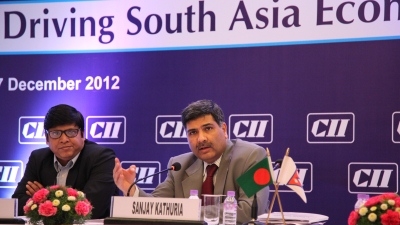NEW DELHI – Economic ties between India and Bangladesh are far below potential. Greater access to each other’s markets, improvements in physical connectivity and transit, and energy trade between India and Bangladesh can help unlock this trade potential, says a new World Bank study.
The study titled “Unlocking Bangladesh-India Trade: Emerging Potential and the Way Forward” says greater engagement in these areas can also stimulate employment and other economic and social activities, which in turn would help reduce poverty (particularly in the border areas), enhance foreign direct investment (FDI) flows, and generate new business opportunities for the private sector.
“Today, South Asia is one of the least integrated regions in the world. Greater bilateral economic cooperation between India and Bangladesh can serve as a critical step for an integrated South Asia,” said Isabel Guerrero, the World Bank’s vice president for the South Asia region.
India is one of Bangladesh‘s primary trading partners. While Bangladesh has a high trade deficit with India, India’s imports from Bangladesh have grown more than sevenfold between FY01 and FY12, while India’s exports to Bangladesh have grown fourfold.
This notwithstanding, Bangladesh accounts for less than 1% of India‘s total imports with a small range of items, mostly fertilizers and jute products. Though ready-made garments constitute Bangladesh‘s major global export, their share in exports to India is very small. However, this could change.
Simulations in the World Bank study indicate that a bilateral Free Trade Agreement between the two countries could increase Bangladesh’s exports to India by 182 percent, and that of India’s to Bangladesh by 126 percent. For India, closer economic cooperation with Bangladesh can be an important stepping-stone to reduce the economic isolation of its northeastern states.
To realize this potential, both countries need to further liberalize trade, reduce tariffs (largely in the case of imports into Bangladesh), reduce and remove non-tariff barriers, and reduce trade costs by improving trade facilitation both at borders and inland, the study says.
In fact, the study suggests that the two countries should go beyond trade in goods to deepen cooperation and improve Bangladesh‘s export capability.
“To enable larger gains, Bangladesh-India cooperation should go beyond goods trade and include investment, finance, services trade, trade facilitation, and technology transfer. This will be a building block toward the larger goal of enhanced regional cooperation,” said Sanjay Kathuria, one of the authors of the study and lead economist, Regional Integration, South Asia region.
The study also highlights the potential of such cooperation. For example, if markets were to open up effectively, Bangladesh could increase its exports of leather and ceramic products to India, while India could increase sugar exports to Bangladesh.
The study observes that foreign direct investment would also help bilateral trade between India and Bangladesh. Inflow of direct investment from India would stimulate Bangladesh’s exports, facilitate technology transfer, and generate employment in Bangladesh. Such investment can also help India gain access to Bangladesh’s market; provide it with a competitive production base; and help India link better with its northeastern states. The energy sector too offers enormous investment and trade opportunities for both countries, particularly in a sub-regional context that includes Bhutan and Nepal.
Lastly, the study points to the very significant potential of trade facilitation. A 10% improvement in the efficiency of clearance processes by border control agencies, including customs, can lead to a 3.9% increase in bilateral trade. A 10% reduction in trade-related documentation can result in a 7.3% increase in bilateral trade. A 1% improvement in overall trade facilitation would result in an almost 4% increase in Bangladesh‘s exports.
“Both governments need to facilitate trade by improving infrastructure at border trading posts, harmonizing trade-related documentation, and minimizing the restrictive element of non-tariff measures. With the general decline in tariff barriers, addressing such costs of trading becomes paramount to ensure continued growth of trade that could, in turn, be a major force in poverty reduction, especially in border areas,” Kathuria added.

